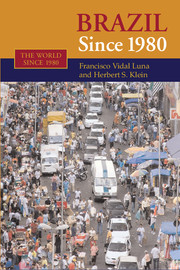Book contents
Conclusion
Published online by Cambridge University Press: 03 June 2010
Summary
In the last quarter century, profound transformations in Brazilian society have occurred. Traditionally agricultural and rural, Brazil is now a modern urban and industrial society. This transformation has affected all regions and all segments of society. Brazil has even made major advances in consolidating a democratic society and more just society. But it has been incapable of changing the historically dramatic inequality of this society.
Like other countries of Latin America, Brazil grew rapidly in the first years of the 1970s. Taking advantage of the strong expansion of the international economy, the abundance of foreign capital and the low interest rates, Brazil, like many third world countries, experienced a period of euphoria, growing at impressive rates, although accumulating disequilibrium in their external accounts. The two oil crises and the quick rise of U.S. interest rates modified this previously favorable environment. The financing of this trade disequilibrium expanded their external debt and made these countries for more dependent on international capital resources. At the same time the wealthiest countries responded to the dual oil crises with recessionary policies that raised interest rates rapidly. These recessive policies had a direct impact on the developing countries, the majority of which found it difficult to service their foreign debts. The pressure on balance of payments grew through the rise of interest rates and the drying up of foreign capital to refinance their existing deficits.
Where Brazil differed from other developing countries was in its response to this new world crisis.
- Type
- Chapter
- Information
- Brazil since 1980 , pp. 236 - 242Publisher: Cambridge University PressPrint publication year: 2006



